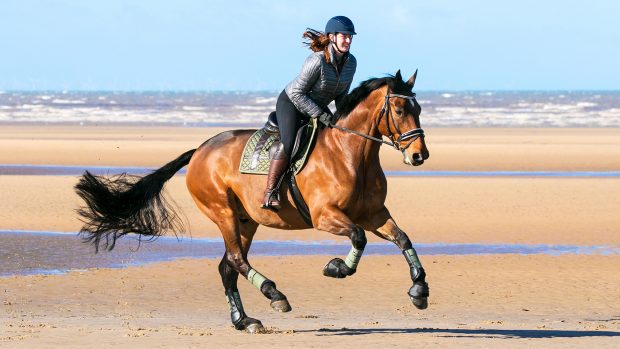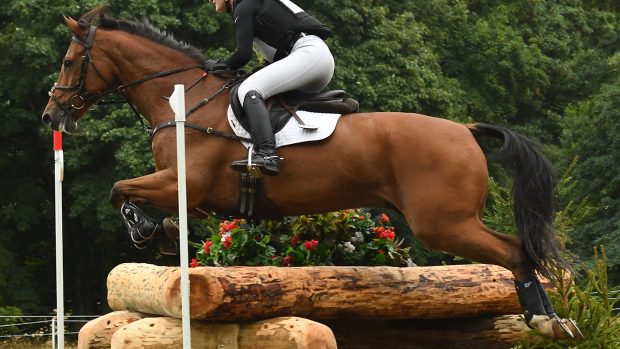If you’re looking to buy a mini show pony for either lead rein or first ridden classes, continue reading so you can learn how to source the correct one for your child.
What is a show pony?
The show pony, or the children’s riding pony, is a type of pony that has its own defined category within showing.
 Watch the video
Watch the videoShow pony classes are usually divided into height sections with each class possessing its own rider age limit.
The four individual classes run 128cm, 138cm, and 148cm sections with a single championship, and lead rein and first ridden show ponies have their own separate classes culminating in their own mini championship.
Show ponies should be elegant, graceful and mannerly, suitable for a child or young person to show. They should possess clean limbs, balanced yet expressive paces, pretty heads and a good length of rein.
Show ponies are judged on an individual show and on their conformation.
The highest level of show pony classes are governed by the British Show Pony Society (BSPS). In the UK, the riding pony stud-book is still administered by the National Pony Society (NPS) — first formed in 1893 as the Polo Pony Stud Book Society.
Show ponies are presented plaited up and in a bridle with a coloured browband. Jockeys wear navy jackets and short jodhpur boots.
- Want to sell your horse? Book a horse for sale advert with Horse & Hound, powered by Whickr
What are the restrictions on mini show ponies?
In the lead rein and first ridden show pony classes, ponies must not exceed 122cm.
Under BSPS rules, riders in lead rein classes must not have attained their eighth birthday before 1 January in the current year. Riders must not be under three years of age. In first ridden classes, a rider is not to have attained their 10th birthday before 1 January in the current year.
In tiny tots first ridden classes, riders must be under eight years of age. Lead rein tiny tops competitors must be aged under five.
Show pony classes are hosted at most shows across the country, from local level to national championships.
What makes a good mini show pony?
Claire Smalley and her mother Ann breed show ponies under the Barkway Prefix. Ponies from the Barkway Stud have won accolades at all major shows, including the Royal International and Horse of the Year Show.
Top ponies from the stud include Barkway Take That, Barkway Black Jack, Barkway Moonfair, Barkway Mr McGregor, Barkway Huckleberry, Barkway Sweet William, Barkway Precocious and Barkway Blackberry. Their home-bred have dominated the line-ups at the HOYS and the RIHS in previous years, too.
“Temperament is key with mini ponies of any type,” says Claire. “You need a pony that is trainable, safe and sensible, especially when it is for a young child. A show pony, though, also needs to have that look-at-me quality. If they are going into the show ring they need to stand out and have a little spark about them that catches the eye.
“Conformation wise, the pony must be of quality. I would not buy anything that is over at the knee. I like a big front and a good shoulder, and a visible position for the saddle. Mini ponies don’t need such a huge engine, but I do like nice, big movement. When you look at a pony everything should be correct and look like it belongs together. A weak back end is never good. Also, something I think I’ve inherited from Mum, is a liking for a very pretty head; it’s the first thing you see.
“I have never been particular about coat colour,” Claire adds. “There are some people who can’t look past some colours, including chestnuts, and favour others, particularly black ponies, but in my opinion colour shouldn’t matter. I also think something a bit different stands out!”
Do lead reins and first riddens differ in type?
Claire says the type of pony you choose will depend on what job you want it for.
“A first ridden will be scopier, have a slightly bigger frame and should stand over more ground than a lead rein,” she says. “At home, we currently have two black youngsters in the field and while from afar they look very similar, on closer inspection they are of a different type. One is dinkier and more petite, the ideal lead rein, while the other has more scope and range, though it’s not necessarily bigger in height. A first ridden should also differ in type to an open 128cm contender.
“It can be beneficial for people to take their first riddens out in lead rein classes at the beginning of their careers, however, to gain experience and learn,” Claire adds.
How much should I pay for a mini show pony?
The prices of mini show ponies will vary depending on many factors, including the show ring CV of the pony.
“The market can vary greatly,” says Claire. “But over the last 20 years we’ve sold three-year-old ponies for between £3,000 and £4,000, on average. Breeders work hard to match bloodlines, keep the mare, get the foal on the ground and keep the pony until it’s aged three or four. If we sell it for around this mark then we’re not making money; it’s definitely a labour of love!
“A pony that has been in the ring and has enjoyed success could easily be worth between £10,000 and £15,000, especially if it’s a safe first ridden with a good temperament,” Claire adds.
Where should I buy a mini show pony from?
There are online sale sites such as Whickr that have show pony lead reins and first riddens advertised throughout the year.
Where you source your new pony from will depend on what stage you would like the animal to be at.
“It depends on your experience, your own set up and your personal finances,” Claire says. “And it also depends if you want to buy a ready made pony or you would rather do it yourself. If you want a pony that is ready to go and you have a child who is of the right age you might be looking at a pony that’s with a producer or in a private home. If you’re wanting a new face you can approach breeders. You’re likely to get more quality for less money if you buy something that is not established.”
I’ve agreed to buy a pony, now what?
It is strongly recommended that you arrange a pre-purchase vetting. If the pony is for a child, perhaps asking for a trial period would be sensible, but not all sellers will agree to this.
It’s important to let the vet know prior to the vetting what you intend to use the pony for so they can assess it with this in mind. If you notify the vet that you want the pony for the show ring, they should inform you of any blemishes or conformational faults which could impact its career.
If the pony is for a child, the vet will hopefully keep an eye on the temperament during the assessment, too. Small ponies can be more susceptible to laminitis so ask the vet to consider this risk.
“Whether or not to proceed with a vetting does depend on how experienced you are, for example, would you be able to spot if a pony shows signs of lameness?” Claire says. “If you are in any doubt about anything then cover yourself with a vetting, and it also depends on how much money you are spending on a pony. I’ve had ponies vetted, and others not, though it’s always a gamble when buying a horse or pony.”
For more information, you can read H&H’s ultimate guide to buying a horse.
- Want to sell your horse? Book a horse for sale advert with Horse & Hound, powered by Whickr
- To stay up to date with all the breaking news throughout London International and more, subscribe to the Horse & Hound website
You may also be interested in:

How to buy the perfect Dartmoor pony for either yourself or a child

Looking to buy a show hunter pony? Where to search and exactly what to look for

Looking to buy a show hunter for weight classes? Read this expert guide to aid your search

How to buy the perfect Welsh section B pony including what to look for and where to start your search

Subscribe to Horse & Hound magazine today – and enjoy unlimited website access all year round





